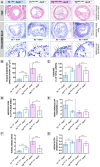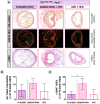Genetic and pharmacological modifications of thrombin formation in apolipoprotein e-deficient mice determine atherosclerosis severity and atherothrombosis onset in a neutrophil-dependent manner
- PMID: 23409043
- PMCID: PMC3567111
- DOI: 10.1371/journal.pone.0055784
Genetic and pharmacological modifications of thrombin formation in apolipoprotein e-deficient mice determine atherosclerosis severity and atherothrombosis onset in a neutrophil-dependent manner
Abstract
Background: Variations in the blood coagulation activity, determined genetically or by medication, may alter atherosclerotic plaque progression, by influencing pleiotropic effects of coagulation proteases. Published experimental studies have yielded contradictory findings on the role of hypercoagulability in atherogenesis. We therefore sought to address this matter by extensively investigating the in vivo significance of genetic alterations and pharmacologic inhibition of thrombin formation for the onset and progression of atherosclerosis, and plaque phenotype determination.
Methodology/principal findings: We generated transgenic atherosclerosis-prone mice with diminished coagulant or hypercoagulable phenotype and employed two distinct models of atherosclerosis. Gene-targeted 50% reduction in prothrombin (FII(-/WT):ApoE(-/-)) was remarkably effective in limiting disease compared to control ApoE(-/-) mice, associated with significant qualitative benefits, including diminished leukocyte infiltration, altered collagen and vascular smooth muscle cell content. Genetically-imposed hypercoagulability in TM(Pro/Pro):ApoE(-/-) mice resulted in severe atherosclerosis, plaque vulnerability and spontaneous atherothrombosis. Hypercoagulability was associated with a pronounced neutrophilia, neutrophil hyper-reactivity, markedly increased oxidative stress, neutrophil intraplaque infiltration and apoptosis. Administration of either the synthetic specific thrombin inhibitor Dabigatran etexilate, or recombinant activated protein C (APC), counteracted the pro-inflammatory and pro-atherogenic phenotype of pro-thrombotic TM(Pro/Pro):ApoE(-/-) mice.
Conclusions/significance: We provide new evidence highlighting the importance of neutrophils in the coagulation-inflammation interplay during atherogenesis. Our findings reveal that thrombin-mediated proteolysis is an unexpectedly powerful determinant of atherosclerosis in multiple distinct settings. These studies suggest that selective anticoagulants employed to prevent thrombotic events may also be remarkably effective in clinically impeding the onset and progression of cardiovascular disease.
Conflict of interest statement
Figures








Similar articles
-
The beneficial effects of a direct thrombin inhibitor, dabigatran etexilate, on the development and stability of atherosclerotic lesions in apolipoprotein E-deficient mice : dabigatran etexilate and atherosclerosis.Cardiovasc Drugs Ther. 2012 Oct;26(5):367-74. doi: 10.1007/s10557-012-6411-3. Cardiovasc Drugs Ther. 2012. PMID: 22940777
-
The effects of direct thrombin inhibition with dabigatran on plaque formation and endothelial function in apolipoprotein E-deficient mice.J Pharmacol Exp Ther. 2012 Nov;343(2):253-7. doi: 10.1124/jpet.112.194837. Epub 2012 Jul 25. J Pharmacol Exp Ther. 2012. PMID: 22837011
-
Targeting Coagulation Factor Xa Promotes Regression of Advanced Atherosclerosis in Apolipoprotein-E Deficient Mice.Sci Rep. 2019 Mar 7;9(1):3909. doi: 10.1038/s41598-019-40602-w. Sci Rep. 2019. PMID: 30846818 Free PMC article.
-
Thrombin generation and atherosclerosis.J Thromb Thrombolysis. 2014 Jan;37(1):45-55. doi: 10.1007/s11239-013-1026-5. J Thromb Thrombolysis. 2014. PMID: 24241912 Review.
-
Beyond Lipoprotein Receptors: Learning from Receptor Knockouts Mouse Models about New Targets for Reduction of the Atherosclerotic Plaque.Curr Mol Med. 2015;15(10):905-31. doi: 10.2174/1566524016666151123110310. Curr Mol Med. 2015. PMID: 26592248 Review.
Cited by
-
Elevated levels of circulating DNA and chromatin are independently associated with severe coronary atherosclerosis and a prothrombotic state.Arterioscler Thromb Vasc Biol. 2013 Aug;33(8):2032-2040. doi: 10.1161/ATVBAHA.113.301627. Epub 2013 Jul 1. Arterioscler Thromb Vasc Biol. 2013. PMID: 23818485 Free PMC article.
-
Anti-inflammatory and antiplatelet effects of non-vitamin K antagonist oral anticoagulants in acute phase of ischemic stroke patients.Clin Transl Med. 2018 Jan 12;7(1):2. doi: 10.1186/s40169-017-0179-9. Clin Transl Med. 2018. PMID: 29335786 Free PMC article.
-
Fibrin Clot Properties in Atherosclerotic Vascular Disease: From Pathophysiology to Clinical Outcomes.J Clin Med. 2021 Jul 5;10(13):2999. doi: 10.3390/jcm10132999. J Clin Med. 2021. PMID: 34279484 Free PMC article. Review.
-
Direct thrombin inhibition with dabigatran attenuates pressure overload-induced cardiac fibrosis and dysfunction in mice.Thromb Res. 2017 Nov;159:58-64. doi: 10.1016/j.thromres.2017.09.016. Epub 2017 Sep 21. Thromb Res. 2017. PMID: 28982031 Free PMC article.
-
Dabigatran and myocardial infarction: a foggy scenario.Vasc Health Risk Manag. 2014 Jan 20;10:45-8. doi: 10.2147/VHRM.S57529. eCollection 2014. Vasc Health Risk Manag. 2014. PMID: 24476689 Free PMC article. No abstract available.
References
-
- Degen JL, Bugge TH, Goguen JD (2007) Fibrin and fibrinolysis in infection and host defense. Journal of thrombosis and haemostasis : JTH 5 Suppl 124–31. - PubMed
-
- Delvaeye M, Conway EM (2009) Coagulation and innate immune responses: can we view them separately? Blood 114: 2367–2374. - PubMed
-
- Massberg S, Grahl L, von Bruehl ML, Manukyan D, Pfeiler S, et al. (2010) Reciprocal coupling of coagulation and innate immunity via neutrophil serine proteases. Nature medicine 16: 887–896. - PubMed
-
- Ross R (1999) Atherosclerosis - an inflammatory disease. N Engl J Med 340: 115–126. - PubMed
-
- Libby P (2002) Inflammation in atherosclerosis. Nature 420: 868–874. - PubMed
Publication types
MeSH terms
Substances
LinkOut - more resources
Full Text Sources
Other Literature Sources
Medical
Molecular Biology Databases
Miscellaneous

